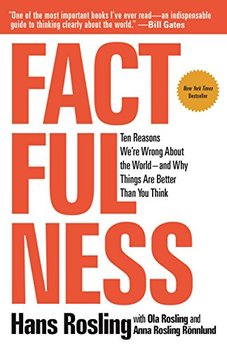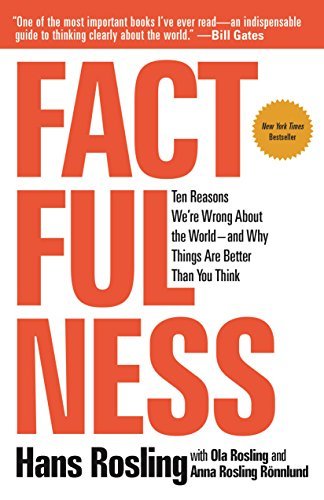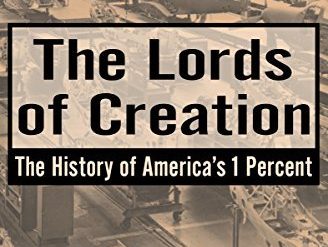
In the closing months of his life, as pancreatic cancer worked its painful way through his system, the legendary lecturer Hans Rosling (1948-2017) labored with his son and daughter-in-law to compile the lessons he had spent decades teaching about the state of the world. The result was this compact and entertaining little book that seeks to explain to us all how badly we understand the state of the human project—and why we don’t know better. In Factfulness, Rosling reminds us that we’re all at the mercy of psychological forces we’re loath to recognize. And in the process he renders a picture of the world today that is more hopeful than we’re likely to have had in mind.
Brilliant graphics to tell an unfamiliar story
Rosling’s central thesis is that the conditions of human life have gotten steadily, and in fact, rapidly better over the past half century—and there’s no disputing the point. “Step-by-step, year-by-year, the world is improving,” he writes. “Not on every single measure every single year, but as a rule.” In his lectures, and in this book, he dramatizes the trend through novel graphics that illustrate the startling decrease in the number of people living in extreme poverty and the corresponding shift upward in the income scale of billions more. The graphics are brilliant. They tell the story of human betterment far more effectively than words can do. You can find them on the Roslings’ website, gapminder.org. But the gist of the argument is that the yawning gap between the world’s have and have-nots is a thing of the past.
Factfulness: Ten Reasons We’re Wrong About the World—and Why Things Are Better Than You Think by Hans Rosling, with Ola Rosling and Anna Rosling Rönnlund (2018) 341 pages @@@@@ (5 out of 5)
Not rich and poor but four income levels
The world is by no means sharply divided into rich and poor, as so many of us seem to believe. In fact, if you group together the world’s people into cohorts by meaningful income levels—an approach Rosling apparently persuaded the World Bank to pursue—you find there are four that make sense:
- At Level 1, some 800 million people still subsist in extreme poverty, earning less than $2 a day. As Rosling notes, “Low-income countries are much more developed than most people think. And vastly fewer people live in them.”
- Level 2 encompasses the roughly three billion people whose daily income falls into the range of $2 to $8. At this level, people can buy food they don’t grow themselves, a gas stove, and mattresses to sleep on.
- The two billion people in Level 3 earn anywhere from $8 to $64 per day. Those who live at this level “can install a cold-water tap” as well as electricity for lighting and a refrigerator. They can afford a motorcycle, too.
- Level 4 defines the world’s richest one billion, with daily incomes upwards of $64. This permits them (us) to attain at least a high-school education, to travel, buy a car, and eat out at least once a month. For comparison, $64 a day translates into slightly less than the $26,200 poverty level for a family of four as currently defined in the United States. And that of course, implies that those who are “rich” by global standards are not necessarily considered prosperous in Europe or North America.
All of which dramatizes Rosling’s point that the overwhelming majority of the world’s people—five billion out of seven in the roundest of numbers—fall into the middle in terms of income and are not either rich or poor. This also underlines the stark reality that “the main factor that affects how people live is not their religion, their culture, or the country they live in, but their income.”
The state of the world in ten chapters
Factfulness is organized in ten chapters, each of which describes one of the many ways that our genetic makeup and the often faulty sources of our information lead people to “misinterpret the facts even when they are right in front of them.” Those sources of our stubborn errors include a tendency to recognize and remember negative facts more so than positive ones, to assume that trends will follow straight lines (when they usually don’t), to generalize from insufficient information, and to believe that nearly everything is urgent when that is so rarely the case. The upshot is that most of us think of the world as it was in 1965 rather than two decades into the twenty-first century. For example, “In 1997, 42 percent of the population of both India and China were living in extreme poverty. By 2017, in India, that share had dropped to 12 percent . . . In China, that share dropped to a stunning 0.7 percent over the same period.”
A breezy, conversational style and many colorful anecdotes
Factfulness is written in an engaging, conversational style. Subheadings sometimes read like punchlines in a standup act, such as “Let’s Beat Up Grandma” and “The Inside of Sister Linda’s Door.” And the book is full of homely and sometimes embarrassing episodes from Rosling’s life as a practicing physician and public health researcher in Sweden, Mozambique, Liberia, Cuba, and the Democratic Republic of Congo, as well as his role as a lecturer to the elite of the world in such venues as TED and the World Economic Forum at Davos.
For a sense of what Rosling’s lectures were like, see “The Best Stats You’ve Ever Seen,” a 20-minute presentation he delivered in February 2006, which has had nearly 15 million views. Rosling’s other TED talks are also available online. These presentations are a joy to take in, as is this book.
The problem with numbers
Rosling bases his arguments about the state of the world on statistics, which is unsurprising but problematic for at least three reasons:
1. Varying quality
The quality and credibility of statistics varies widely from country to country. Anyone working in development in countries Rosling prefers not to call “poor” is well aware that the numbers reported by government agencies are often fanciful and sometimes downright unrelated to reality. And these are the numbers on which World Bank and UN statistics are based—the statistics Rosling relies on.
2. Purchasing Power Parity
Rosling reports his observations based on the US dollar, as does the World Bank. However, few countries in the world transact local business in US dollars. The workaround used by the World Bank and other international institutions is something called Purchasing Power Parity (PPP), a notoriously unreliable way to compare, say, an average Indian peasant’s income in rupees with salaries of European or American office workers denominated in dollars or euros. Calculations of PPP invariably make poor people’s income look greater than it is.
3. Percentages are not real numbers
Rosling uses percentages as the measure of reality—for example, he makes the claim that only 9% of the world’s people now live in extreme poverty, which he takes to mean daily income of less than $2. (The World Bank now says $1.90.) Quite apart from the other problems with this claim (which I dispute), the fact remains that 9% of today’s world population of 7.8 billion is 702,000,000. ) In other words, even using the rosiest numbers Rosling prefers, nearly three-quarters of a billion people live in destitution today. And, in fact, I believe the true number is likely to be at least twice if not three times as great, in which case as many people today would be living in extreme poverty today as the total population of the world in 1950 (2.6 billion), when the world started paying attention to such things.
Despite what I’ve written here, I want to emphasize that I am in full agreement with the broad conclusions Rosling reached, even though some of the numbers he uses may be shaky. It’s only when you take the statistics he reports as a precise picture of the world in all particulars that I slide into disagreement with him.
For the record
Dutiful reader that I am, I took the 13-question quiz Rosling laid out in the opening of his book. For the record, I answered eight of his questions correctly. I was shocked that I got so many wrong—and astonished to learn that only a tiny fraction of 1% of the thousands he quizzed got eight or more right. One person got eleven. Nobody, twelve. And among the tens of thousands to whom Rosling administered the test were groups of Nobel Laureates and medical researchers, who were among those who performed most poorly.
For further reading
For an even broader view of the state of the world, see Gaining a global perspective on the world around us.
I’ve reviewed four other books on closely related subjects:
- The Signal and the Noise: Why So Many Predictions Fail—But Some Don’t, by Nate Silver (How experts make sense of the world (or don’t) with statistics)
- The Tyranny of Metrics, by Jerry Z. Muller (Every manager should read this book about the use and misuse of metrics)
- Big Data: A Revolution That Will Transform How We Live, Work, and Think, by Viktor Mayer-Schoeneberger and Kenneth Cukier (From two experts: The coming Big Data revolution)
- Naked Statistics: Stripping the Dread from the Data, by Charles Whelan (How Netflix, Wall Street, and economists use and misuse statistics)
You might also be interested in:
- Third World poverty and economic development: a reading list
- 20 top nonfiction books about history
- The top 10 books on the economics of poverty
- Science explained in 10 excellent popular books (plus dozens of others)
And you can always find my most popular reviews, and the most recent ones, plus a guide to this whole site, on the Home Page.


























